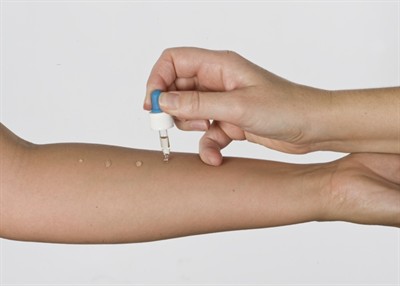 The theory behind skin prick testing, skin puncture testing and scratch testing is the same though methods very slightly. The most commonly performed is the skin prick test which is relatively pain free and fast. Scratch testing has been losing favor and some patients report more discomfort and scaring from scratch testing compared to skin prick testing.
The theory behind skin prick testing, skin puncture testing and scratch testing is the same though methods very slightly. The most commonly performed is the skin prick test which is relatively pain free and fast. Scratch testing has been losing favor and some patients report more discomfort and scaring from scratch testing compared to skin prick testing.
The Skin Prick Test Done
A very small amount of a possible allergen is placed on a area of the body, usually the forearm or back. The skin is than pricked with a sterile needle point to allow the allergen to enter. The tester notes if the skin begins to react in the form of hives or rash. The size of any outbreak on the skin is also measured.The size helps the allergist or doctor who is performing the test grade the reaction, there are a few different scales used for grading the reactions. Usually many allergens will be tested on the skins surface in a grid that has been marked out on back or forearm.
Negative Control: The power of the mind is so great that the mere mention of a test can cause the skin to react with rashes in some people. For this reason a negative control is used in the test. The negative control can be nothing more than a saline solution. If the skin reacts to the negative control than all results of the skin prick test can be considered suspect.
Positive Control: A positive control like histamines is also used to induce a reaction on the skin.
What Else You Should Know About Skin Prick Testing
Antihistamines should be avoided before the test. Your doctor will tell you the exact period of time you should stop taking them before the scheduled test.
The skin prick test relies a great deal on the qualifications of who interprets and performs the test. Go with the most qualified professional you can find preferably a allergist.
False positives are not uncommon where there is a reaction from a allergen during the test even though the patient experiences no problems with the allergen in normal life.
False negatives also occur even with a allergen the patient is allergic to.
Skin prick testing is considered accurate by many but it will only help diagnose those allergens that produce a IgE antibody response.
